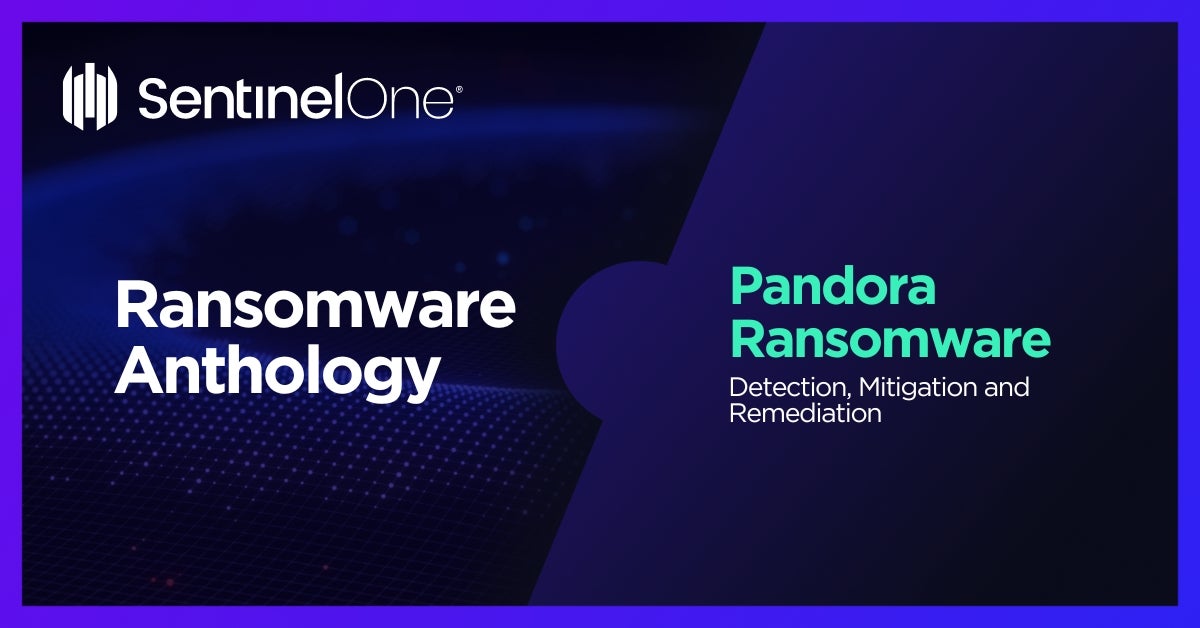Pandora Ransomware: In-Depth Analysis, Detection, and Mitigation
Summary of Pandora Ransomware
The Pandora ransomware family emerged in March of 2022. Pandora is an evolution of Rook ransomware. That said, much of Pandora’s code is based on Babuk. Babuk’s source code has been leaked in multiple forms and anything derived from it is known to have an unclear lineage.
Pandora practices double extortion – demanding payment for a decryptor, as well as for the non-release of stolen data.

What Does Pandora Ransomware Target?
Pandora ransomware targets a wide range of industries, including healthcare, finance, education, and government agencies.
How Does Pandora Ransomware Spread?
Pandora is deployed in multiple ways: via Cobalt Strike( or a similar framework), and through email phishing. Additionally, brute force attacks against RDP services, to gain initial access, have been seen in Pandora campaigns.
Pandora Ransomware Technical Details
Pandora, like Rook, is typically delivered via a third-party framework (e.g, Cobalt Strike). Initial access is achieved via brute-forcing RDP or similar exposed protocols. Payloads are commonly UPX packed from a Visual C++ source. Pandora is known for its speed, which is achieved via efficient multithreading. When executed, Pandora will also display one (or more) visible CMD windows (also similar to Rook). The group rose to prominence upon the launch of their TOR-based victim blog, which mirrors the common format. Pandora is still a multi-pronged extortion outfit, carrying out ransomware attacks in addition to public leakage of data should the victims fail to comply.
How to Detect Pandora Ransomware
- The SentinelOne Singularity XDR Platform can identify and stop any malicious activities and items related to Pandora.
In case you do not have SentinelOne deployed, detecting this ransomware requires a combination of technical and operational measures, which are designed to identify and flag suspicious activity on the network. This allows the organization to take appropriate action, and to prevent or mitigate the impact of the ransomware attack.
- Use antimalware software, or other security tools, which are capable of detecting and blocking known ransomware variants. These tools may use signatures, heuristics, or machine learning algorithms, to identify and block suspicious files or activities.
- Monitor network traffic, and look for indicators of compromise, such as unusual network traffic patterns, or communication with known command-and-control servers.
- Conduct regular security audits and assessments, to identify vulnerabilities in the network and the system, and to ensure that all security controls are in place and functioning properly.
- Educate and train employees on cybersecurity best practices, including how to identify and report suspicious emails, or other threats.
- Implement a robust backup and recovery plan, to ensure that the organization has a copy of its data, and can restore it in case of an attack.
How to Mitigate Pandora Ransomware
- The SentinelOne Singularity XDR Platform can return systems to their original state using either the Repair or Rollback feature.
In case you do not have SentinelOne deployed, there are several steps that organizations can take to mitigate the risk of ransomware attacks:
- Educate employees: Employees should be educated on the risks of ransomware, and on how to identify and avoid phishing emails, malicious attachments, and other threats. They should be encouraged to report suspicious emails or attachments, and to avoid opening them, or clicking on links or buttons in them.
- Implement strong passwords: Organizations should implement strong, unique passwords for all user accounts, and should regularly update and rotate these passwords. Passwords should be at least 8 characters long, and should include a combination of uppercase and lowercase letters, numbers, and special characters.
- Enable multi-factor authentication: Organizations should enable multi-factor authentication (MFA) for all user accounts, to provide an additional layer of security. This can be done through the use of mobile apps, such as Google Authenticator or Microsoft Authenticator, or through the use of physical tokens or smart cards.
- Update and patch systems: Organizations should regularly update and patch their systems, to fix any known vulnerabilities, and to prevent attackers from exploiting them. This includes updating the operating system, applications, and firmware on all devices, as well as disabling any unnecessary or unused services or protocols.
Implement backup and disaster recovery: Organizations should implement regular backup and disaster recovery (BDR) processes, to ensure that they can recover from ransomware attacks, or other disasters. This includes creating regular backups of all data and systems, and storing these backups in a secure, offsite location. The backups should be tested regularly, to ensure that they are working, and that they can be restored quickly and easily.